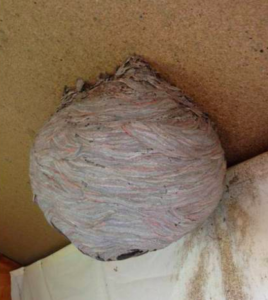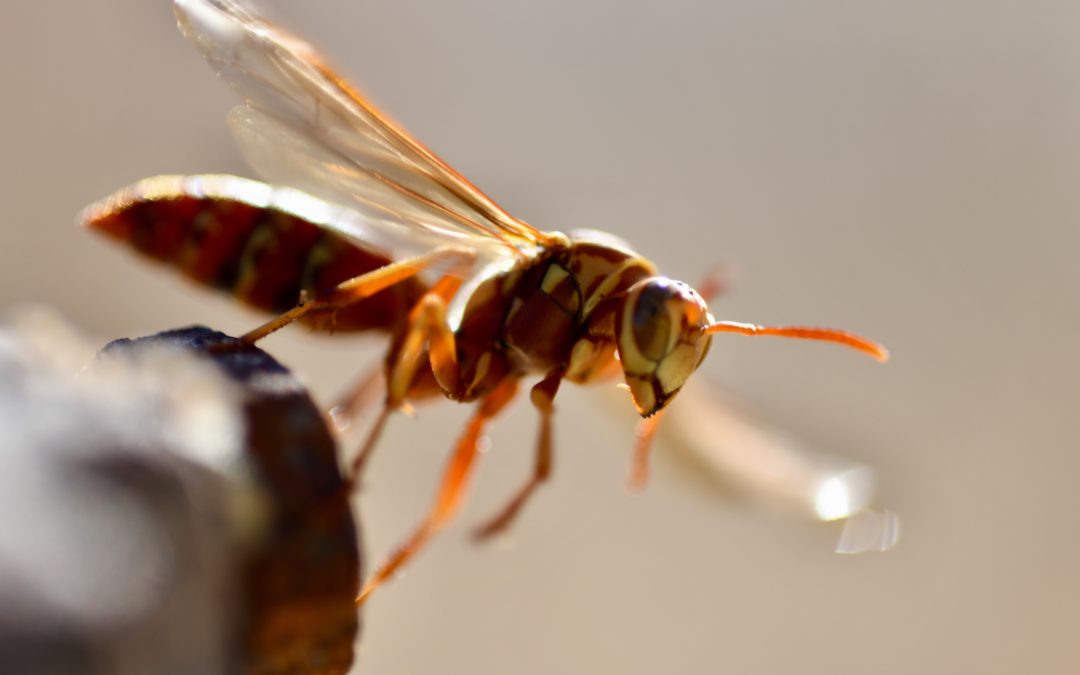During the hot summer days and longer nights, a few especially annoying pests will have a tendency to show up. Pests that love to ruin our our time in the great outdoors: wasps.
Often times when a homeowner discovers a nest on their property, they will attempt to resolve the issues themselves. However, it is highly advised that you do not attempt to remove a wasp nest without professional help, as this will most likely do more damage than good. The process can be dangerous and as such, you should contact a licensed profesional to deal wth the problem.
Keep reading below to learn what you should and should not do when dealing with wasp nests.
All Wildlife and Pest Control’s government licensed technicians can safely and quickly remove the wasp’s nest for you.
If you are beginning to notice wasps around your home or business call us immediately at 1-877-221-2999
RIGHT APPROACH TO WASP NEST REMOVAL
The best way to remove a wasp nest is by contacting a pest control professional and leaving the heavy lifting to the trained professionals. It may seem like an easy job, but a pest control expert is professionally trained to handle and remove wasp nests in a safe and efficient manner, and here’s why:
- Safety equipment: An pest control technician has access to all the proper safety safety equipment, they are not only dealing wiht aggressive wasps but also chemicals and sprays that require training and proper handling. This fully protects them from wasp stings, ensuring their safety when removing a wasp nest
- Working in small spaces: Pest specialists are trained and qualified to work in small spaces such as your attic allowing them to safely and efficiently deal with the problem.
- Expert knowledge: Trained and licensed technicians are experts; they know all about their behavior and instincts as well as how to identify the signs of an allergic reaction to wasp stings.
- Professional products: Wasp exterminators have access to, and are professionally trained to use a variety of pest control products not available to the public. These products are more powerful than any DIY products on the market and have a proven track record of successfully removing wasp nests.
WRONG APPROACH TO WASP NEST REMOVAL
Wasps are aggressive pests and require little motivation to attack, therefore removing a nest is not only dangerous, but often times will end up costing you more in the long run. DIY wasp nest removal is not a smart idea. There is plenty of information online advising the best DIY methods, all of which are sure to be a waste of your time and money. Please read the following carefully before taking any action, these are some of the approaches you may read about:
- Using fire to deal with a wasp nest is a very dangerous idea and rarely is this approach successful in dealing with the nest. Because wasp nests are made of fibrous, highly flamable materials this appraoch is extremely dangerous. Wasps will checw up wood and once it dies it takes on an paper like consisitency. For those reasons, attempting to remove the nest by setting it on fre will not only pause a serious danger to yourself, but to your home as well. Another problem with burning a wasp nest is that it is not an effective way to control a wasp problem. This is because it doesn’t kill all the wasps. It can lead to the remaining wasps in the nest becoming violent, as well as the wasps out foraging for food, resulting in them attacking you and any bystanders.
- Using water is tactic often suggessted to deal with wasp nests. The truth is that flooding a wasp nest isn’t an effective method at all. Depending on the location of the nest, using water to remove a wasp nest can result in further damages to your property. Trying to flood a nest won’t get rid of all the wasps inhabiting the hive either. Much like with trying to burn a wasps nest, attempting to flood it will aggravate the wasps and put you at risk. Not a smart approach.
- Destroying a wasp nest with a bat, racket or any other item is another talked about removal option. This approach will most likely end with you being stung and can be particularly dangerous if you are allergic to wasp stings as you could go into anaphylactic shock.
This method of DIY wasp nest removal puts you in close proximity to the hive, which is often enough to aggravate them to trigger an attack. Trying to remove a wasp nest using a baseball bat can often result in you being stung before the task has started.
IDENTIFYING A WASP NEST
How to successfully identify a wasp nest  and determine the specific species you are dealing with.
and determine the specific species you are dealing with.
Out of the wasps that do build their own nests, the size, look and materials used may vary depending on a few factors:
- the species
- the country you are in
- whether they are social or solitary wasps.
Also, nests are sometimes built in the ground, or can be seen hanging from tree branches, eaves of buildings, or other supports as aerial nests.
Aerial wasp nests are typically greyish or straw-coloured in appearance. Keep an eye out for any signs around your property and contact us immediately if you suspect you may have a wasp nest on your property.
WASP NEST PREVENTION
Following the steps below can help prevent wasps from building their nest in your home and/or garden:
- Perform regular maintenance to ensure all cracks and potential entry points are sealed.
- Install fly screens on windows and doors to prevent wasps from getting in.
- Invest in wasp traps and place them around areas you notice activty. You can also make one yourself, check out this link to learn how.

